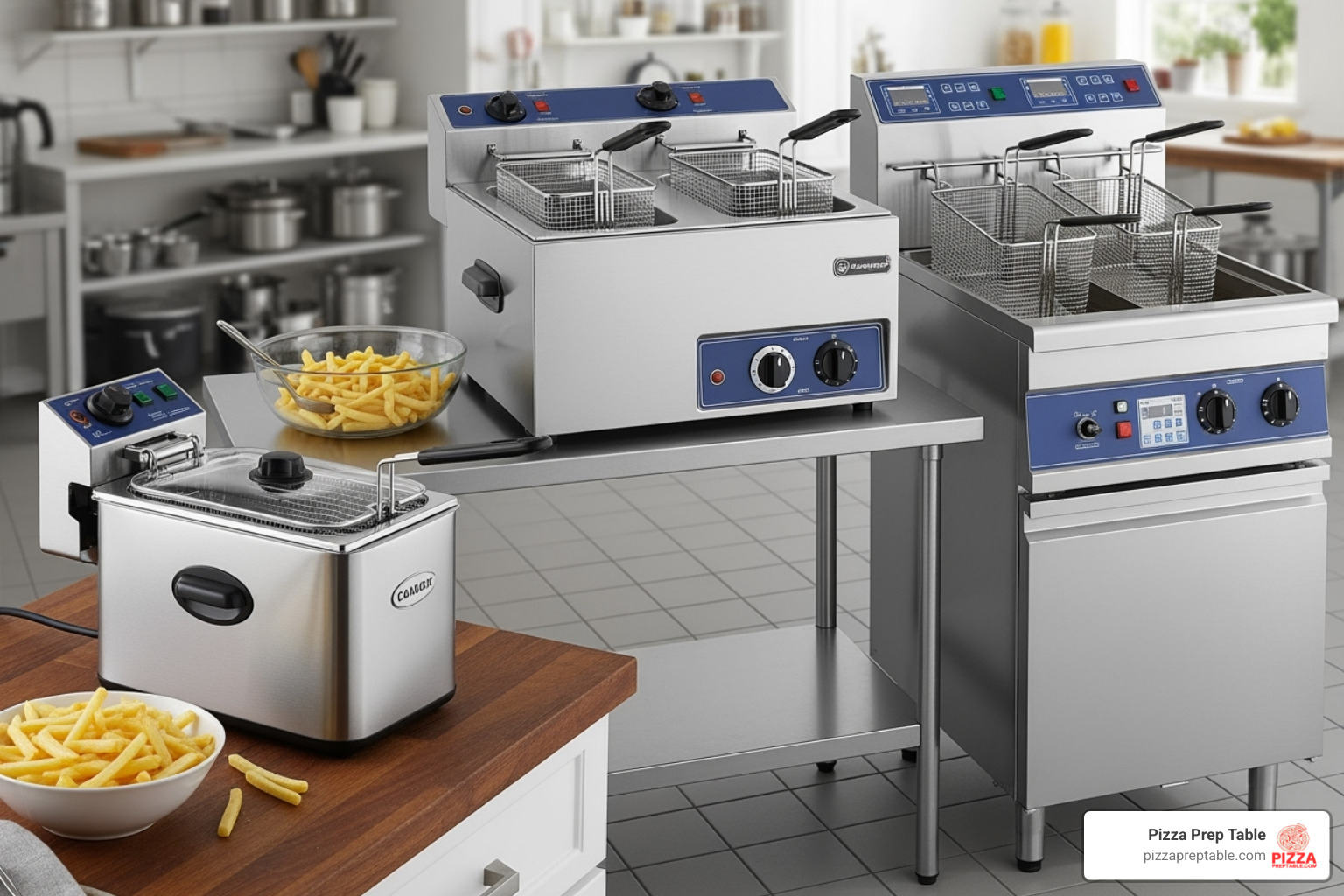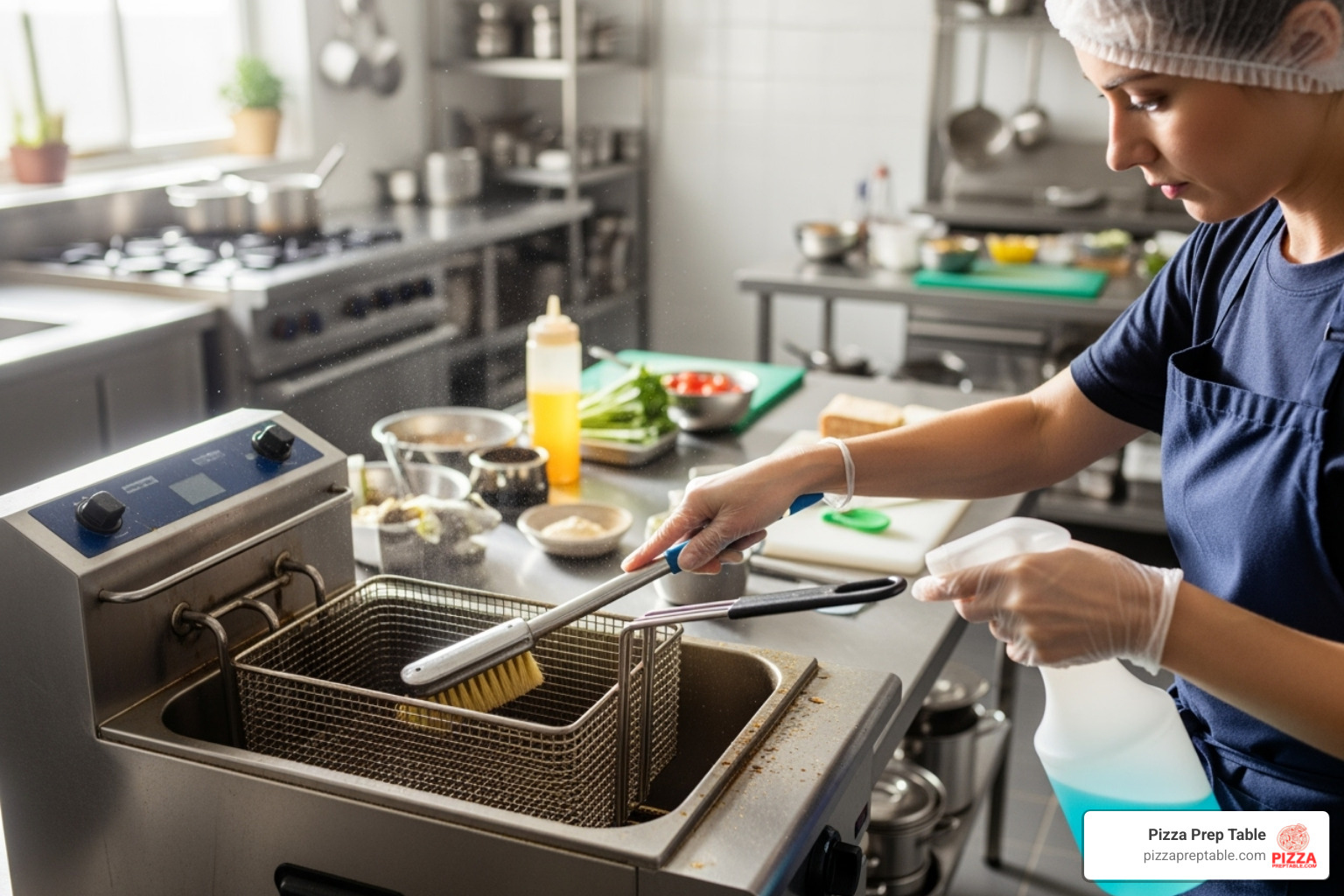
Deep Fryers: Everything You Need to Know Before You Fry
Share
What Deep Fryers Can Do for Your Kitchen
A deep fryer is a specialized cooking appliance that heats oil to high temperatures (typically 350-375°F) to cook food by complete immersion, creating the signature crispy exterior and tender interior that makes fried foods so irresistible.
Key Deep Fryer Benefits:
- Superior taste and texture - Creates crispy, golden results impossible to achieve with other cooking methods
- Consistent results - Maintains precise oil temperature automatically
- Faster cooking - Cooks food 3-4 times faster than oven baking
- Professional quality - Restaurant-style results in your own kitchen
- Versatile cooking - Perfect for everything from french fries to donuts to tempura
Deep fryers deliver an unbeatable combination of crispy texture and juicy interior by creating an instant seal around food, locking in moisture while developing a perfect golden crust.
This guide covers choosing, using, and maintaining your deep fryer, from the different types available to essential safety tips.
I'm Sean Kearney, and my experience in foodservice sales has shown me how a quality deep fryer can transform a menu and boost profitability. The right tools make all the difference.

Easy deep fryer word list:
How a Deep Fryer Works and Why You Need One
Ever wonder what makes restaurant fries taste so much better than homemade ones? The secret isn't just the oil or the potatoes—it's the deep fryer itself and how it works its magic.
When food enters a deep fryer, hot oil (350-375°F) surrounds it via convection heat transfer. This even cooking instantly turns surface moisture to steam, creating a golden, crispy crust that seals in natural juices.
Deep fryers excel over pan frying thanks to thermostat technology. A built-in thermostat constantly monitors and adjusts the oil temperature, eliminating guesswork and inconsistency.
Most electric models use an immersed heating element for direct, efficient heating. Powerful elements (1700W-1800W) ensure oil heats quickly and recovers temperature fast, even after adding cold food.
The flavor improvement is remarkable. Instant searing locks in moisture, creating a perfect crispy texture that other methods can't replicate, keeping chicken juicy inside with a crunchy exterior.
Speed is another game-changer. French fries go from raw to golden in just 5-6 minutes. Chicken wings are ready in 10-12 minutes. Even a whole turkey can be done in about 3½ minutes per pound—try beating that with your oven!
Perhaps the best reason to invest in a deep fryer is for consistent results. It eliminates burnt exteriors with raw centers or soggy fries, delivering perfection every time.
Many modern units also feature Cool Zone technology, a clever innovation that keeps burnt food particles from settling at the bottom and scorching. This extends your oil's life and keeps flavors clean, making your deep fryer more economical and efficient in the long run.
Choosing the Right Deep Fryer for Your Kitchen

Finding the perfect deep fryer means matching it to your space, cooking style, and needs. Whether for home use or a busy food truck, the right choice transforms your cooking. From compact countertop units to commercial powerhouses, there's a fryer for every situation. Let's explore the options.
Types of Deep Fryers: From Home Kitchens to Food Trucks
Electric fryers dominate the home kitchen scene. These user-friendly, plug-and-play units use an immersed heating element. Models range from compact 1.5L units for small portions to family-sized 3.5L fryers with features like oil filtration.
Power ranges from 800 watts for smaller models to 1800 watts for serious home units. More watts means faster heating and temperature recovery, which is crucial for crispy results.
Gas and propane fryers are the workhorses of commercial kitchens. Using gas burners, these fryers offer best heating and recovery times, making them essential for high-volume operations. If you're ready to upgrade your commercial setup, our guide on how to Cook Like a Pro with These Commercial Gas Deep Fryers covers everything you need to know.
Countertop models bridge the gap between home and commercial use. These models offer significant capacity without permanent installation, perfect for smaller restaurants, food trucks, or serious home cooks.
Commercial units are the heavy-hitters designed for non-stop operation. These range from large countertop to floor-standing units with capacities up to 20.80 Qt. They are built for durability and consistent performance in busy kitchens. Check out our selection to Electrify Your Menu with These Commercial Electric Deep Fryers.
For businesses watching cash flow, our Rent-Try-Buy program lets you test commercial equipment before committing, with 60% of rental payments crediting toward purchase.
Key Features to Look For in a Deep Fryer
Capacity is your first big decision. Capacity needs vary: 1.5L to 2L is great for singles or couples, families often need 4-5L models, and commercial kitchens may require 30+ quarts.
Power matters. For home use, look for 1500W to 1800W. Higher wattage ensures faster heating and temperature recovery, preventing soggy food.
Adjustable temperature control provides the flexibility to cook different foods at their ideal temperatures, typically between 350°F and 375°F.
Digital timers help prevent overcooking, allowing you to multitask without worry.
Multiple baskets allow for frying different items at once, but be aware that some designs may have smaller individual baskets.
Safety features shouldn't be optional. Look for cool-touch exteriors, magnetic safety cords that detach easily to prevent spills, and viewing windows to monitor food without losing heat.
Removable, dishwasher-safe parts make cleanup bearable. This feature saves time, especially with systems that offer automatic oil draining and filtering.
Innovative Technology and Special Features
Modern deep fryers have gotten seriously smart. Automatic oil filtration systems automatically drain, filter, and store used oil, extending its life and reducing waste.
Odor reduction systems with active filtration are a great feature for small living spaces.
Digital controls offer more precise temperature and timing than analog dials, which serious cooks appreciate.
Cool Zone technology prevents food debris from burning at the vat bottom, extending oil life and preventing off-flavors. Some units even offer rotisserie functions for handling whole chickens with impressive results.
Top-rated models earn their reputation through consistent performance. Here are a couple of examples known for their reliability:
- Presto FryDaddy: Praised for its simple reliability and ease of use.
- Hamilton Beach Professional Grade: Recognized for its quality and long-term satisfaction.
Deep Fryer vs. Pan Frying
A dedicated deep fryer offers clear advantages over pan frying:
| Criteria | Deep Fryer | Pan Frying |
|---|---|---|
| Cooking Method | Food is fully immersed in oil, cooked evenly from all sides. | Food is partially immersed, requiring flipping to cook both sides. |
| Taste & Texture | Consistent, all-over crispness with a tender interior; less oil-sogged when done correctly. | Can result in uneven crispness; may absorb more oil if not managed carefully. |
| Health Considerations | Both use oil, but deep frying can create a crisper, less oily product if the oil is at the correct temperature and food is not overcrowded. | Often uses less oil overall, but food can be oilier if not drained properly. |
| Cooking Time | Faster and more efficient due to complete oil contact and consistent temperature. | Slower, as only one side cooks at a time; requires more active attention. |
| Ease of Cleanup | Dedicated oil management systems (filtration, storage) and removable, dishwasher-safe parts simplify cleanup. | Requires cleaning a pot/pan, often with stubborn oil residue. |
The temperature control alone makes a deep fryer worth considering. Pan frying often leads to temperature swings that result in greasy food, while a good deep fryer maintains consistent heat for professional results every time.
Getting Started: Popular Foods and Frying Techniques
Now for the fun part: cooking. Your deep fryer can handle everything from classic comfort foods to special-occasion treats, quickly becoming your kitchen's MVP.
Start with crowd-pleasers like French fries and fried chicken, which achieve a perfect crispy coating while staying juicy inside. For seafood, fish and chips brings the pub experience home, while tempura offers a more delicate, airy coating for vegetables and shrimp. Don't forget sides like onion rings or sweets like churros and donuts. The possibilities are endless, including chicken wings, jalapeño poppers, and even a whole turkey in an outdoor fryer (about 3½ minutes per pound at 350°F).
Choosing the right oil is key. Choose oils with a high smoke point (above 400°F/204°C) to prevent burning. Canola oil is a great all-purpose choice due to its neutral flavor and affordability. Peanut oil adds a subtle nutty flavor, while vegetable oil is a reliable, budget-friendly option. Grapeseed oil has a very high smoke point but is pricier. Avoid low-smoke-point oils like olive oil or butter, as they will burn and ruin your food's flavor.
For an extra-crispy texture like in restaurants, use the double frying technique. First, fry food at a lower temperature (325-350°F) until cooked through but not yet golden. Let it drain. Then, increase the oil to 375°F and fry for a second time for 2-4 minutes. This creates an incredible crunch while keeping the inside tender, and it's especially effective for French fries.
Remember the golden rule of frying: never overcrowd your basket! Give your food room to breathe. When you pack too much in at once, the oil temperature drops dramatically, leading to greasy, soggy results instead of that crispy perfection you're after. Patience pays off with beautifully fried food every time.
Safety, Cleaning, and Maintenance: The Essentials

A deep fryer is a fantastic tool, but it requires respect. Working with hot oil and keeping the unit clean are crucial for safety, flavor, and the longevity of your appliance. Proper maintenance is key to getting years of perfectly fried foods and avoiding safety hazards or equipment failure.
Essential Deep Fryer Safety Tips
Working with hot oil requires your full attention and respect. The oil in your deep fryer can cause serious burns, so let's cover the essential safety practices that should become second nature.
Hot oil handling is critical. Never move a deep fryer when it's hot or contains oil. The oil can reach 375°F and cause severe burns. Always let the oil cool completely before handling or cleaning the unit.
Preventing splatters starts with dry food. Pat food with paper towels and shake excess ice off frozen items. Lower the basket slowly and carefully into the oil.
Here's a life-saving rule: never add water to hot oil. It creates a violent, explosive reaction that can cause serious burns and fires.
Your deep fryer needs stable surface placement. Place it on a stable, flat, heat-resistant surface away from the edge. Keep it clear of children, pets, and traffic, and ensure proper ventilation.
Use built-in safety features like auto shutoff, but don't rely on them entirely. Be cautious even with cool-touch exteriors, as they can still get warm. A magnetic safety cord is a valuable feature that prevents the fryer from being pulled off a counter if the cord is snagged.
Even with built-in thermostats, it's wise to use a separate probe thermometer such as the Thermapen ONE to verify the oil's temperature. This ensures accuracy for both safety and perfect cooking results.
When using outdoor turkey fryers, operate them on a flat, non-combustible surface far from any structures or flammable materials. Never overfill the oil, as adding the turkey can cause a dangerous overflow.
Cleaning and Maintaining Your Deep Fryer
Proper cleaning is about maintaining food quality and extending the life of your equipment. A well-maintained fryer produces better-tasting food and operates more safely.
Cooling the oil is the first rule of cleaning. Let it cool completely to room temperature before handling, which can take several hours. Rushing this step is dangerous.
To reuse oil, let it cool, then strain it through a fine-mesh sieve to remove food particles. Store it in an airtight container in a cool, dark place. Replace oil after 8-10 uses, or when it becomes dark, foamy, or develops an off smell. Avoid cross-contaminating flavors between different food types.
Proper oil disposal is crucial. Never pour it down the sink. Once cooled, pour it into a sealed, disposable container and place it in the trash. For commercial operations with larger volumes, proper disposal becomes even more critical. Check out our guide on Keep Calm and Store On: Food Truck Fryer Oil Storage Tips for professional-level advice.
Many fryers have dishwasher-safe parts like baskets and lids, simplifying cleanup. The heating element usually cannot be submerged; wipe it carefully with a damp cloth once cool and ensure it's dry before use. To clean the vat, remove the oil, wipe out residue with paper towels, then wash with warm, soapy water. Rinse and dry completely before refilling. Use soft cloths on non-stick surfaces to avoid scratches.
Regular maintenance ensures your deep fryer will perform safely and reliably for years, producing delicious results every time.
Frequently Asked Questions about Deep Fryers
Here are answers to the most common questions about getting the most from your deep fryer.
What is the best oil for a deep fryer?
The best oils have a high smoke point, typically above 400°F (204°C). This means they can handle the intense heat of deep frying without breaking down. Canola oil is a top all-purpose choice for its neutral flavor and affordability. Peanut oil is great for its stability and nutty flavor. Vegetable oil is a versatile, budget-friendly option. Avoid low-smoke-point oils like olive oil or butter, which will burn and impart a bitter taste.
How often should I change the oil in my deep fryer?
As a rule, change your oil after 8-10 uses. However, you should change it sooner if it becomes dark, cloudy, foamy, or develops an "off" flavor. Heavily battered foods break down oil faster. To extend its life, strain your oil after each use to remove food particles.
Can I put frozen food directly into a deep fryer?
Yes, you can fry frozen foods directly without thawing. For safety, shake off any excess ice crystals to prevent splattering. Crucially, do not overcrowd the basket. Frying frozen food in small batches prevents the oil temperature from dropping, which is the key to avoiding soggy results and achieving a crispy texture.
Conclusion
We've covered how a deep fryer's combination of hot oil and precise temperature control creates irresistible textures and how to choose between the many available models.
A dedicated deep fryer delivers superior taste and texture that stovetop methods can't match. It transforms ordinary ingredients into extraordinary meals, from perfect French fries to restaurant-quality fried chicken.
Choosing the right model is key. A compact home unit is perfect for the enthusiast, while a robust commercial deep fryer is the backbone of a professional kitchen. Match the equipment to your needs and space.
Safety always comes first. Respect hot oil by developing good habits for handling, cooling, and maintenance. Let the unit cool completely, dispose of oil responsibly, and always be mindful of safety features.
Whether for a home kitchen or a busy pizzeria in New York City, Los Angeles, or Chicago, the right deep fryer makes all the difference. At Pizza Prep Table, we know the right equipment transforms menus and boosts success.
Ready to take the next step? Explore our full range of commercial kitchen equipment to find the perfect tools for your culinary creations. From compact countertop models to heavy-duty commercial units, we're here to help you find exactly what you need to make your kitchen – and your food – shine.

